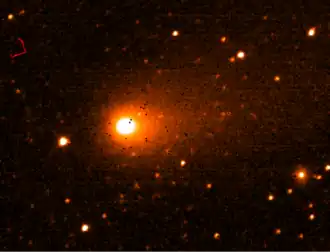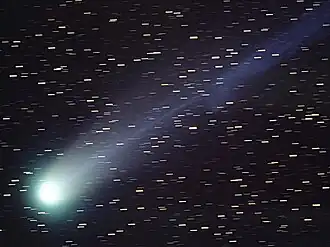C/2012 X1 (LINEAR)
 The comet on 18 May 2014 by NEOWISE | |
| Discovery[1] | |
|---|---|
| Discovered by | LINEAR |
| Discovery site | Socorro, New Mexico |
| Discovery date | 8 December 2012 |
| Designations | |
| CK12X010[2] | |
| Orbital characteristics[3] | |
| Epoch | 18 December 2013 (JD 2456644.5) |
| Observation arc | 1,038 days (2.84 years) |
| Aphelion | 305.1 AU |
| Perihelion | 1.599 AU |
| Semi-major axis | 153.33 AU |
| Eccentricity | 0.98957 |
| Orbital period | ~1,900 years |
| Max. orbital speed | 33.2 km/s |
| Inclination | 44.367° |
| 113.146° | |
| Argument of periapsis | 132.114° |
| Last perihelion | 21 February 2014 |
| TJupiter | 1.152 |
| Earth MOID | 0.752 AU |
| Jupiter MOID | 1.066 AU |
| Physical characteristics[4] | |
| Dimensions | 1.8–3.6 km (1.1–2.2 mi) |
Mean diameter | 2.8 km (1.7 mi) |
| Comet total magnitude (M1) | 5.5 |
| Comet nuclear magnitude (M2) | 10.8 |
| 8.5 (2013 apparition) | |
Comet LINEAR, formal designation C/2012 X1, is a non-periodic comet that was observed telescopically from 2012 to 2015. It produced a powerful outburst on 21 October 2013, which raised its brightness 100 times its expected magnitude from 12 to 8.5 for several months.[5]
Discovery and observations
An asteroid-like object with an apparent magnitude of 19.4 was spotted with cometary activity from images taken by the Lincoln Near-Earth Asteroid Research survey on the night of 8 December 2012.[1]
From April 2014 onwards, the comet slowly faded away as it made its way back to the outer Solar System. It was last observed from Australia as a 20th-magnitude object about 7.0 AU (1.05 billion km) from the Sun on 9 December 2015.
References
- ^ a b D. W. Green (12 December 2012). "Comet C/2012 X1 (LINEAR)". Central Bureau for Astronomical Telegrams. 3340. Bibcode:2012CBET.3340....1B.
- ^ G. V. Williams (12 December 2012). "MPEC 2012-X70: Comet C/2012 X1 (LINEAR)". www.minorplanetcenter.net. Minor Planet Center. Retrieved 31 December 2024.
- ^ "C/2012 X1 (LINEAR) – JPL Small-Body Database Lookup". ssd.jpl.nasa.gov. Jet Propulsion Laboratory. Retrieved 3 January 2024.
- ^ D. C. Jewitt (2022). "Destruction of Long-period Comets". Astronomical Journal. 164 (4): 158–166. arXiv:2208.04469. Bibcode:2022AJ....164..158J. doi:10.3847/1538-3881/ac886d.
- ^ D. Dickinson (23 October 2013). "Comet LINEAR Suddenly Brightens with Outburst: How to See It". Universe Today. Retrieved 31 December 2024.
External links
- C/2012 X1 at the JPL Small-Body Database

.png)